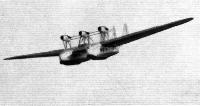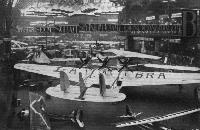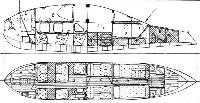
Описание
Страна : Италия
Год : 1931
Летающая лодка
22-местная пассажирская летающая лодка
Варианты
- Savoia-Marchetti / SIAI - S.55 - 1924 - Италия
- Savoia-Marchetti / SIAI - S.63 - 1927 - Италия
- Savoia-Marchetti / SIAI - S.66 - 1931 - Италия
Savoia-Marchetti S.66
Трехмоторная пассажирская летающая лодка S.66 создавалась на замену очень удачному самолету S.55P. Она сохранила двухкорпусную схему предшественника, но ее корпуса стали больше и получили элегантные обводы.
Совершивший первый полет в 1931 году, прототип (получивший военный серийный номер MM229) был оснащен тремя 500-сильными (373 кВт) 12-цилиндровыми ПД Fiat A.22R водяного охлаждения, вращавшими толкающие винты. Пилоты размещались в закрытой кабине в передней кромке центроплана крыла. В каждом корпусе первоначально размещалось по семь пассажирских кресел, два спальных места и туалет. Корпуса и крыло были выполнены из дерева, а хвостовые балки и оперение - из стальных труб с полотняной обшивкой.
Компания "Savoia-Marchetti" построила 23 серийных самолета, оснащенных более мощными двигателями Fiat A.24R, в каждом из корпусов которых размещались по 11 пассажиров.
Коммерческая эксплуатация S.66 началась в конце 1933 года; самолеты использовались итальянскими авиакомпаниями "Aero Espresso Italiana", "Societa Idrovolanti Alta Italia" (SIAI), "Navigazione Aerea" и "Societa Aerea Mediterranea" (SAM). Их S.66 перешли по наследству новой итальянской национальной авиакомпании "Ala Littoria", эксплуатировавшей эти лодки до 1939 года. Несколько самолетов применялись итальянскими ВВС для поисково-спасательных операций в годы Второй мировой войны.
ТАКТИКО-ТЕХНИЧЕСКИЕ ХАРАКТЕРИСТИКИ
Savoia-Marchetti S.66
Тип: 22-местная пассажирская летающая лодка
Силовая установка: три рядных ПД Fiat A.24R мощностью 750 л. с. (559 кВт)
Летные характеристики: максимальная скорость 238 км/ч; потолок 5350 м; максимальная дальность полета 1200 км
Масса: пустого снаряженного 7450 кг; максимальная взлетная 10950 кг
Размеры: размах крыла 33,00 м; длина 16,65 м; высота 4,90 м; площадь крыла 126,70 м2
Описание:
- Savoia-Marchetti S.66
- Flight, October 1932
THE SAVOIA-MARCHETTI S.66 - Flight, November 1932
THE PARIS AERO SHOW
Фотографии
-
Aeroplane Monthly 1989-01 / J.Stroud - Wings of Peace
Регистрационный номер: I-ABRA [2] AN ITALIAN COMMERCIAL SEAPLANE: The Savoia-Marchetti S.66 twin-hull mono flying-boat. This machine, which was described in our issue for October 13 last, is a development of the S.55 type (which made the formation Atlantic flight in 1930-31) but is fitted with three 500-h.p. Fiat A.22R engines.
I-ABRA, the prototype S.66. -
Jane's All the World Aircraft 1980 / Encyclopedia of Aviation - Aircraft A-Z - v5
Savoia-Marchetti S.66.
-
Aeroplane Monthly 1989-01 / J.Stroud - Wings of Peace
Регистрационный номер: I-REDI [2] SAM's S.66 I-REDI at the Aeroporto Carlo del Prete, Ostia.
-
Air Pictorial 2002-05 / M.Wickstead - The Origins of Alitalia
Регистрационный номер: I-ALTE One of nine Savoia-Marchetti S.66 twin-hulled flying-boats operated by the Ala Littoria SA in the 1930s. Powered by three 700hp Fiat A24R 12-cylinder engines, the S.66 carried seven passengers in each hull with the pilot located in the wing centre section.
-
Мировая Авиация 230
По сути, S.66 представлял собой увеличенный вариант S.55, оснащенный тремя, а не двумя двигателями. Самолет на снимке принадлежал авиакомпании «Ala Littoria».
-
Aeroplane Monthly 1989-01 / J.Stroud - Wings of Peace
Регистрационный номер: I-VALE S.66 I-VALE in Ala Littoria livery.
-
Aeroplane Monthly 1989-01 / J.Stroud - Wings of Peace
Регистрационный номер: I-REDI [2] This view of SAM’s S.66 I-REDI clearly shows the flying-boat’s twin-boom layout.
-
Aeroplane Monthly 1989-01 / J.Stroud - Wings of Peace
Регистрационный номер: I-EGEO The 11th S.66, I-EGEO, after transfer to Ala Littoria.
-
Flight 1932-10 / Flight
The Savoia-Marchetti S.66 twin-hull, three-engined monoplane in flight.
-
Flight 1932-11 / Flight
Регистрационный номер: I-ABRA [2] FROM THE GALLERY: The Grand Palais as it appears when viewed from the Northern end. In the foreground the Italian stand.
-
Flight 1934-11 / Flight
A NEW REGIME: On October 28 Mussolini celebrated the anniversary of Rome's capitulation to Fascism by, among many other ceremonies, inaugurating the new combine of all the Italian Air Lines into one body called Ala Littoria, which means, in a broad sense, the Fascist Wing. Our photograph, taken at the seaplane port of Ostia, near Rome, shows men painting out the company's old name and painting in the new name in anticipation of the ceremony. The flying boat is a Savoia Marchetti S 66 which runs between Rome and Tripoli.
-
Flight 1934-01 / Flight
SIR JOHN SIMON IN ROME: The Foreign Secretary flew from Capri to Ostia in an Italian seaplane on January 3. On his arrival at Rome (shown here) he spent two hours with Signor Mussolini.
-
Aeroplane Monthly 1989-01 / J.Stroud - Wings of Peace
The rear of the starboard side of an S.66 cabin. The door led to the sleeping compartment.
-
Aeroplane Monthly 1989-01 / J.Stroud - Wings of Peace
Регистрационный номер: I-FBAA KEITH WOODCOCK’S painting depicts Savoia S.66 I-FBAA Citta di Tunisi, in the colours of Ala Littoria.
-
Flight 1932-10 / Flight
THE SAVOIA-MARCHETTI S.66: Internal arrangement of one of the hulls. A = Forecastle and entrance to main cabin. B = Main passenger cabin. C = Passengers' luggage compartment. D = Sleeping berths and aft entrance. E = Freight and mail compartment.
-
Flight 1932-10 / Flight
Savoia-Marchetti S.66 3 Fiat A22-R 500 h.p. Engines
- Фотографии















